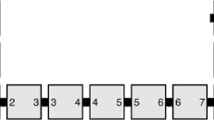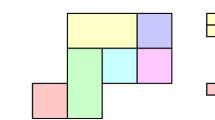Abstract
Self-assembly is the process by which objects aggregate independently and form complex structures. One of the theoretical frameworks in which the process of self-assembly can be embedded and formally studied is that of tile systems. A Wang tile is a square unit, with glues on its edges, attaching to other tiles which have matching glues, and forming larger and larger structures. In this paper we concentrate over two basic, but essential, self-assembling structures done by Wang tiles. The first one, called ribbon, is a non-self-crossing wire-like structure, in which successive tiles are adjacent along an edge, and where tiles are glued to their predecessor and successor by use of matching glues. The second one, called zipper, is a similar contiguous structure, only that here, all touching tiles must have matching glues on their abutting edges, independently of their position in the structure. In case of Wang tiles, it has been shown that these two structures are equivalent. Here we generalize this result for the case when the tiles have eight glues, four on their edges and four on their corners. Thus we show that an eight neighborhood dependency, namely the Moore neighborhood, can be simulated by a quasi-linear dependency.











Similar content being viewed by others
References
Adleman L, Kari J, Kari L, Reishus D, Sosik P (2009) The undecidability of the infinite ribbon problem: implications for computing by self-assembly. SIAM J Comput 38(6):2356–2381
Amoroso S, Patt Y (1972) Decision procedures for surjectivity and injectivity of parallel maps for tessellation structures. J Comput Syst Sci 6:448–464
Barish R, Rothemund P, Winfree E (2005) Two computational primitives for algorithmic self-assembly: copying and counting. Nanoletters 5(12):2586–2592
Czeizler E, Kari L (2009) Geometrical tile design for complex neighborhoods. Comput Neurosci 3:20
Grünbaum B, Shephard GC (1987) Tilings and patterns. W. H. Freeman and Company, New York
Kari J (1994) Reversibility and surjectivity problems of cellular automata. J Comput Syst Sci 48:149–182
Rothemund PWK (2001) Theory and experiments in algorithmic self-assembly. Ph.D. thesis, University of Southern California
Rothemund P, Papadakis N, Winfree E (2004) Algorithmic self-assembly of DNA Sierpinski triangles. PLoS Biol 2:12
Wang H (1961) Proving theorems by pattern recognition—II. Bell Syst Tech J 40(1):1–41
Wang H (1965) Games, logic and computers. Sci Am 213(5):98–106
Winfree E (1998) Algorithmic self-assembly of DNA. Ph.D. thesis, California Institute of Technology
Acknowledgements
The idea and the design of the Moore tiles from Sect. 4 are due to L. Adleman. Initially, they were called pitcher-tiles due to their shape. This research was supported by Natural Sciences and Engineering Council of Canada Discovery Grant R2824A01, Canada Research Chair Grant X3159A34, and Faculty of Science Grant R2824A03 to L.K., and Academy of Finland, project number 203667, and Foundation of Å bo akademi University for E.C.
Author information
Authors and Affiliations
Corresponding author
Rights and permissions
About this article
Cite this article
Czeizler, E., Kari, L. Towards a neighborhood simplification of tile systems: From Moore to quasi-linear dependencies. Nat Comput 10, 103–117 (2011). https://doi.org/10.1007/s11047-010-9193-1
Published:
Issue Date:
DOI: https://doi.org/10.1007/s11047-010-9193-1




